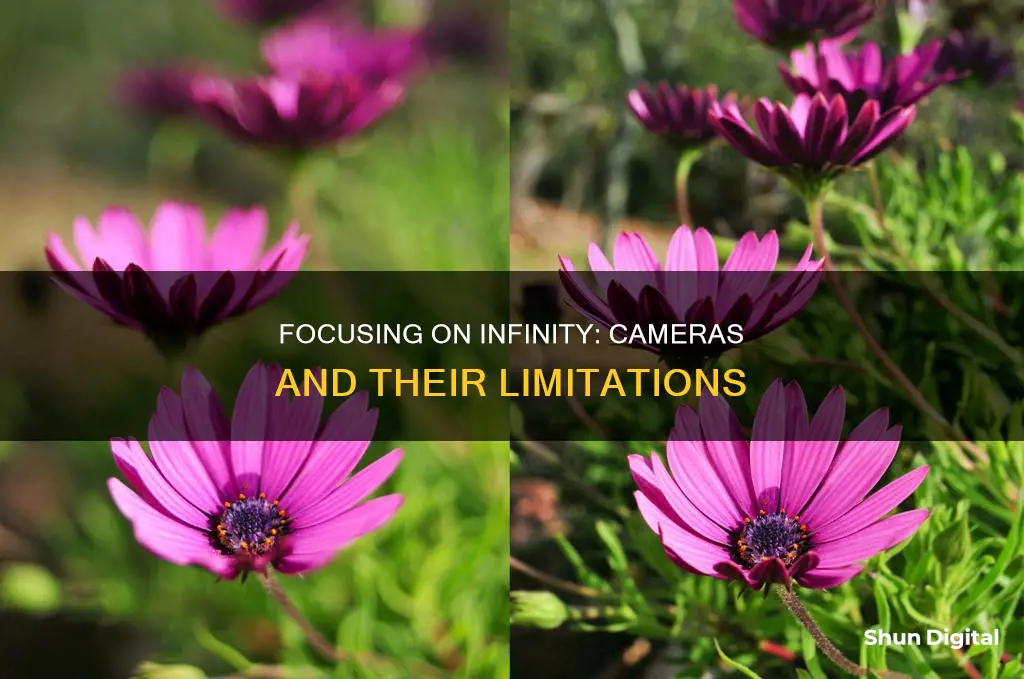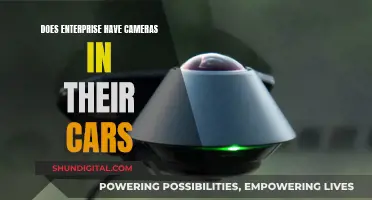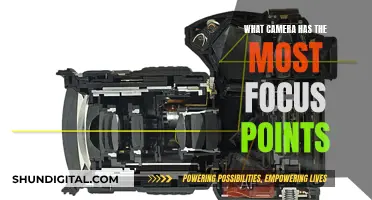
Cameras are unable to focus on everything in a picture due to limitations in their lenses and apertures. Lenses only allow certain light waves to focus on the photo-taking electronics or film. To see up close, the light from further objects has to be obscured. While pinhole cameras can focus on everything at all distances, they let in very little light, and increasing the hole's size to let in more light blurs the image. Autofocus systems are also not very intelligent and rely on contrast and light to determine where to focus. They struggle in low-contrast and low-light situations, as well as with reflections and smudges on glass and wire enclosures.
| Characteristics | Values |
|---|---|
| Lenses | Only allow certain light waves to focus on the photo-taking electronics or film |
| Light | To see up close, the light from further objects has to be obscured |
| Pinhole cameras | Have everything in focus at all distances, but let in very little light |
| Aperture | The smaller the aperture, the more in focus |
| AF sensors | Dirty AF sensors can impair the ability of your camera to focus precisely |
| AF mode | The wrong AF mode can be a problem for poor AF performance |
| AF Point Outline | The red or yellow AF points are not always consistent with where the AF point is actually positioned |
| Lens Contacts | Dirty lens contacts impair the ability to lock focus accurately |
| Technique | Poor technique can result in image blur or out-of-focus results |
| Subject/Sensor | Tough subjects and incorrect sensor choice can result in poor auto-focusing performance |
What You'll Learn

Cameras focus on a single point, not multiple points
Cameras have a limited number of autofocus points, and even when all of these points are active, they can only focus on one distance at a time. This is because cameras focus on a single plane, and everything in front of and behind that plane will be out of focus. The size of this plane depends on the aperture of the lens, with smaller apertures increasing the depth of field and keeping more of the image in focus. However, even with a small aperture, the camera can only focus on one plane at a time, and objects at other distances will be out of focus.
The autofocus system in cameras is not very intelligent and uses visual cues based on contrast and light to determine where to focus. This can lead to problems in low-contrast or low-light scenes, where the camera may struggle to lock focus. Additionally, autofocus can be hindered by reflections, smudges, or obstructions such as glass or wire in front of the desired subject. In these situations, switching to manual focus may be necessary.
The depth of field also depends on the focal length of the lens and the distance from the subject. Wide-angle lenses have a larger depth of field, while telephoto lenses have a smaller one. Getting further away from the subject can also increase the depth of field, but this may not always be possible or desirable compositionally.
To get everything in focus, a very small aperture is required, which in turn requires more light and a slower shutter speed. This can lead to camera shake and blurry photos, so a tripod is often necessary. Additionally, the aperture needs to be perfectly round, which most cameras cannot achieve.
In summary, while it is possible to increase the depth of field and get more of the image in focus, cameras are fundamentally limited to focusing on a single plane at a time. This is due to the physical limitations of the lens and the autofocus system, which is not intelligent enough to focus on multiple points simultaneously.
Diagnosing Camera Battery Issues: Is It Time for a Replacement?
You may want to see also

Lenses need calibrating to focus accurately
Lenses need to be calibrated to ensure accurate and precise focus. Calibration involves fine-tuning the autofocus system of a camera so that the lens and autofocus chip are aligned and "seeing the same thing".
Causes of Misalignment
There are several reasons why a lens may need calibrating. Firstly, all cameras and lenses are manufactured with a certain range of accuracy, and slight margins of error in the positioning of components can occur. When these small discrepancies are combined, they can result in a more significant issue that takes the focus out of the acceptable range. This problem is more likely to occur when using older lenses with new camera bodies, or vice versa.
Secondly, lenses can be shipped with focus outside of the acceptable range, although this is more common with cheaper lenses due to less stringent quality control.
Thirdly, over time, the communication between the lens and the camera's autofocus chip can shift, causing the focus to be off. This means that even if a lens was sharp and accurate when first purchased, calibration may be needed later on.
Signs that a Lens Needs Calibration
If the image appears focused in the viewfinder but is blurry when viewed on a computer screen, this could indicate a need for lens calibration. For example, if the focus is intended for a person's eye but lands on their shoulder instead, the focus is off, and calibration may be required.
Calibration Process
The calibration process involves taking a series of photos in a controlled manner to identify how the focus is off. This can be done using a lens calibration tool, such as a calibration chart or focus pyramid, or a DIY setup with a ruler. The camera is set up on a tripod in a well-lit environment, and photos are taken with the lens set to the widest aperture to identify any focus issues.
After reviewing the photos, the camera's autofocus settings are adjusted to correct the focus. This process is repeated until the desired focus is achieved.
Benefits of Calibration
Calibration can improve the accuracy of focus and reduce the occurrence of slightly out-of-focus photos. However, it is important to note that calibration is just one aspect of achieving sharp focus, and other factors such as focusing techniques and strategies also play a significant role.
Do Traffic Cameras Affect Your Driving Record?
You may want to see also

Cameras struggle to focus in low-light conditions
Additionally, the quantum efficiency of image sensors, which refers to the efficiency of converting photons into electrical signals, can diminish in low light. This results in reduced photon collection and conversion, impacting the overall light utilisation. Manufacturers strive to improve quantum efficiency to enhance low-light performance. Another challenge is the aperture setting; widening the aperture to let in more light results in a shallower depth of field, causing a narrower range of the image to be in focus. Achieving the right balance between aperture, depth of field, and focus is crucial for sharp low-light images.
Autofocus mechanisms in cameras rely on detecting contrast or phase differences, which become harder to discern in low-light conditions, leading to slower and less accurate autofocus. Some cameras use infrared or auxiliary lighting to assist in autofocus, while manual focus can also be an option. Dynamic range limitations further impact low-light performance, as the range of light intensities a camera can capture is reduced, resulting in clipped highlights or crushed shadows. Techniques like HDR imaging help overcome this by capturing multiple exposures and blending them to retain details in bright and dark areas.
While advancements in low-light imaging have been made, the challenges of capturing sufficient light, reducing noise, maintaining focus, and preserving image quality persist. These factors collectively contribute to the difficulties cameras face in focusing and performing optimally in low-light environments.
Switching Up S7 Camera Modes: A Guide
You may want to see also

Cameras focus on the closest object, causing obstructions
To overcome this issue, photographers can try to place the most defined edge in the centre of the frame and lock the focus before recomposing and shooting. Alternatively, switching to manual focus can be more effective in certain situations.
Another common issue is when there are near obstructions, such as glass or wire, between the camera and the subject. The lens will try to focus on the obstruction instead of the intended subject. To solve this problem, photographers can try changing their angle to minimise reflections or put the lens flat against the glass to block out reflections.
Additionally, when shooting in macro mode, autofocus can become confused due to the extremely shallow depth of field. In such cases, it is generally recommended to switch to manual focus and use a tripod to ensure a steady shot.
Finally, when shooting fast-moving subjects, autofocus may struggle to keep up. Pre-focusing on a specific spot and waiting for the action to arrive can be a good strategy in such situations.
Numbering Images in Camera Raw: A Beginner's Guide
You may want to see also

Cameras struggle to focus on fast-moving objects
Capturing fast-moving objects in sharp focus is one of the biggest challenges in photography. When an object is moving, it can be very difficult for a camera to keep up and focus.
- Choose a fast lens with a large aperture, especially when shooting from a distance or in low-light conditions. Look for a lens with an f-stop of 2.8 or better.
- Get closer to your subject and use a flash to freeze the motion and produce sharper images.
- Increase the ISO setting to make your camera more light-sensitive, allowing you to use faster shutter speeds.
- Set your camera to Shutter Speed Priority (S or TV) mode, which lets you adjust the shutter speed while the camera sets the aperture.
- Use a fast shutter speed (typically over 1/250 of a second) to completely freeze the motion and capture sharp images of fast-moving objects. For emotional moments, such as a basketball player making a rebound, use a shutter speed of at least 1/500 of a second or higher.
- Alternatively, use a slower shutter speed (between 1/50 and 1/100 of a second) to create a sense of movement and blur, which can be effective for capturing the motion of cars, bikes, or runners.
- Adjust your camera's autofocus area mode to single-point autofocus if there are obstacles between you and your subject. This prevents the camera from accidentally focusing on something other than your subject.
- Use autofocus area modes such as Dynamic AF-Area Mode (Nikon) or AF Point Expansion (Canon) to cover a larger area and track your subject's movement.
- Set your focus tracking duration based on how quickly you need to focus on a different subject and whether your subject is moving in an expected trajectory without interruption.
- Use back button focus by separating the focus function from the shutter release button. This allows you to lock focus with the back button and capture the shot with the shutter button without the camera trying to refocus.
- Pre-focus on a point where you expect your subject to be, such as a horse jumping over a fence or a runner crossing the finish line.
- Use vibration reduction (VR) or image stabilization (IS) settings to reduce blur when panning with moving objects or photographing stationary objects.
- When photographing with a shutter speed faster than 1/500, turn off VR/IS as it won't be needed.
Street Camera Tickets: How Long Before They Arrive?
You may want to see also
Frequently asked questions
Cameras can't focus on everything because their lenses only allow certain light waves to focus on the photo-taking electronics or film. Lenses allow for a large hole to let light in, but they focus the light so it isn't blurry. The trade-off is that lenses can only be in focus at a certain distance.
Common autofocus problems include dirty AF sensors, incorrect AF mode, the AF point outline being off, dirty lens contacts, tough subjects, and incorrect sensor choice.
To get everything in focus, you need to select a very closed aperture like F22. As you increase your aperture number, the subjects closer and further away from the subject in focus become sharper.







